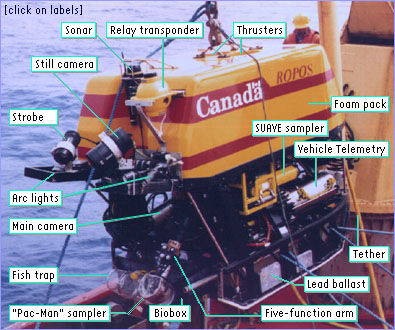
|
 |
 |
Meet ROPOS by Peter Tyson ROPOS may look like an upended refrigerator, but what it lacks in form it more than makes up for in function. The Remotely Operated Platform for Ocean Science has more gadgets than you can shake a five-function arm at (which is one of those gadgets, by the way). Take a closer look at this deep-sea robot, one of only four in the world that can dive to depths of more than 10,000 feet. (Just don't get too close to that five-function arm. According to a ROPOS technician, "its jaw could take your arm off.")  Thrusters ROPOS is powered by pressurized hydraulic fluid. Two vertical hydraulic thrusters lie in here. There are also two lateral and two fore-aft thrusters. All told, ROPOS has 30 horses under the hood when in deep mode, which currently allows dives to about 10,000 feet but that will soon increase to almost 17,000 feet. (In shallow-water, "liveboat" mode—that is, in less than 1,200 feet of water and tethered directly to the ship—ROPOS is a 40-horsepower machine.) Foam pack The foam filling this pack aids buoyancy and is so dense that it cannot be made any denser by the enormous pressure at 10,000 feet. It might be foam, but it ain't light: when in "liveboat" mode, ROPOS tips the scales at 3,600 pounds, while in deep mode (shown here), which features nothing more than a fatter foam pack, it weighs in at a full 6,000 pounds. (back to diagram) Vehicle telemetry Unlike most equipment on ROPOS, which adjusts to the pressure at depth, this titanium cylinder maintains one atmosphere of pressure—the same as at the surface. It houses the delicate telemetry system, which guides the robot based on instructions coming down through the tether from the joystick-wielding pilot high above. On the other side of ROPOS is a separate science telemetry system. Tether The 1,000-foot-long tether connects ROPOS to the cage, which has its own 11,800-foot electrical-optical cable to the surface. All data, from directional commands sent down from the pilot sitting in the mother ship to live imagery beamed up from ROPOS, travel through this thin umbilical. SUAVE sampler This flow-injection device samples hydrothermal vent water and analyzes it for dissolved minerals such as sulfur, lead, gold, and silver. (back to diagram) Lead ballast Whenever a piece of equipment is added to or removed from ROPOS, these lead weights are removed or added to compensate. Fine-tuning the vehicle's trim, which is kept slightly positive, is vital to ensuring the highest maneuverability. Five-function arm The five functions are shoulder up/down, elbow, yaw, wrist rotate, and jaw open/close. There is also a seven-function arm (not visible in this picture), with, in addition to those above, wrist up/down and wrist yaw. Both arms can lift 600 pounds at full extension. Biobox Beneath the five-function arm is a hydraulically activated "biobox." Measuring roughly 30 inches long by a foot wide and high, it can be thrust out, its lid open and shut, and then pulled back in. (back to diagram) "Pac-Man" sampler Resembling the video-game snapper, this is the jaw that could bite your arm off (see above). It's used to collect samples of known volume from the seabed. Not visible in this photo, ROPOS also has a rotating sample tray with four sub-dividable compartments, and a variable-speed, reversible suction sampler that can pump a respectable 78 gallons a minute. Fish trap This cylindrical trap, known to many a fisherman, is simply set down on the bottom and picked up later. ("We've caught octopus, crab, seems like everything but fish," a ROPOS technician admitted.) Camera This is ROPOS' main camera. It's a Sony DXC-950 broadcast-quality color NTSC camera with 16x zoom. Out of sight in this photograph is the SIT, a very-wide-angle, very-low-light camera. ROPOS' cage also has its own camera. (back to diagram) Arc lights These are 250-watt arc lights, which are brighter and closer to daylight than the 250-watt incandescent light (seen just in front of the arc light that is to the right in the picture). Together, the lights illuminate the ocean floor out to between 50 and 75 feet ahead. Strobe This is the strobe light for the main camera. Still camera This was a still camera temporarily installed by the University of Victoria for a specific mission. (back to diagram) Sonar This scanning, color-imaging sonar, modified with a lower frequency and narrow-beam head for enhanced long-range response, allows ROPOS to "see" perhaps 350 feet ahead. Such long-range vision is invaluable in navigating through the highly variable terrain of a spreading center, where the black smoker chimneys may be found. Relay transponder This relay transponder "pings" continuously. Its signals are bounced off an acoustic net of transponders placed nearby on the seafloor. The time lag of each return determines where on the bottom ROPOS is at any given time. The tracking is integrated with differential GPS, the ship's heading, and wind speed and direction. All told, this navigation system enables ROPOS pilots to know where their charge is to within 20 feet. (back to diagram) Peter Tyson is Online Producer of NOVA. Birth of an Expedition | Mission Plan | Dispatches Through the Porthole | Meet the Team Meet ROPOS (JavaScript/Frames-capable browser required) Meet ROPOS (No Frames/JavaScript) Illustration: IFREMER/Violaine Martin. The Mission | Life in the Abyss | The Last Frontier | Dispatches E-mail | Resources | Table of Contents | Abyss Home Editor's Picks | Previous Sites | Join Us/E-mail | TV/Web Schedule About NOVA | Teachers | Site Map | Shop | Jobs | Search | To print PBS Online | NOVA Online | WGBH © | Updated October 2000 |